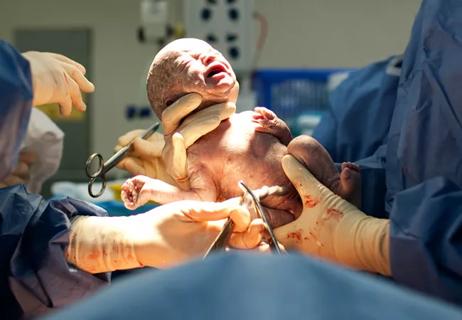Postpartum perineal lacerations are underdiagnosed and undertreated

Obstetric lacerations are common in women who deliver vaginally, but in a minority of cases, they lead to obstetric anal sphincter injuries (OASIS), which can have serious negative consequences. Despite the impact of OASIS, the condition is under-diagnosed and under-treated, according to Cleveland Clinic urogynecologists Lisa C. Hickman, MD, and Katie Propst, MD.
Advertisement
Cleveland Clinic is a non-profit academic medical center. Advertising on our site helps support our mission. We do not endorse non-Cleveland Clinic products or services. Policy
Writing in the American Journal of Obstetrics & Gynecology, the two have issued a call to action for increased awareness of OASIS, accurate diagnosis and appropriate management of the injuries via ongoing education and training at all levels of practice.
“Rates of OASIS range from 2% to 10% of vaginal deliveries, and because the condition is so infrequent, we believe that care is likely not optimal for most women,” says Dr. Propst. “It is vital to improve provider education and skills in laceration repair and it must be an ongoing endeavor.”
Twenty percent of women with OASIS experience immediate postpartum complications, such as bleeding from the laceration site, increased pain and wound infection, and 25% have wound breakdown that may require subsequent surgery. Likelihood of bowel control issues, short-term anal incontinence and rectovaginal fistula formation also is significantly increased when OASIS occurs.
“A third- or fourth-degree tear more than doubles the risk of wound infection,” says Dr. Propst. “Fecal incontinence and pain are more common in women with a history of OASIS, and for some, they become long-term problems.”
Tracking the true impact of OASIS historically has been difficult because of lack of a classification of perineal lacerations, a situation that was remedied only eight years ago. The latest data on incidence are from the 1998-2010 U.S. Nationwide Inpatient Sample database.
“Before 2012, when the reVITALize Obstetric Data Definitions Conference issued a standard classification of perineal lacerations, there was no consistent way of describing these kinds of injuries,” says Dr. Propst. “The best data we have are a decade old. We’re working to get updated data so we have more accurate numbers.”
Advertisement
In the past, the situation also may have been complicated by a misperception on the part of some clinicians that a delivery complicated by OASIS represented a failure in care. Says Dr. Propst, “For a while, a third- or fourth-degree tear was considered a quality measure, so I think there was a stigma attached, and not a lot of enthusiasm for reporting these cases.”
Another factor that may contribute to under-identification of OASIS, according to the authors, is how assessment of perineal lacerations is performed. A check of all tissue layers of the peritoneum and a digital rectal examination should be routine after any vaginal delivery.
Factors that increase risk of OASIS include primiparity, a long duration of pushing, episiotomy, and infant birthweight > 4000 g. Operative vaginal delivery (use of forces or vacuum) is the factor that increases risk the most.
“In any woman with risk factors for OASIS, consider two examiners so OASIS isn’t missed,” she says. “We know that when you have multiple examiners, the rate of diagnosis goes up, and we can’t improve outcomes if we don’t identify the lacerations.”
Once OASIS has been identified, proper repair is crucial. But both training at the residency level in an evidence-based approached and experience with the condition in obstetric practice are inadequate.
Says Dr. Propst, “Residents have limited opportunities to learn these skills and studies show that their confidence with repair of OASIS has decreased. I encourage our residents to observe or assist third- and fourth-degree repairs whenever the opportunity arises because they may learn something even if they aren’t doing the repair.”
Advertisement
For obstetric providers who may see few cases of OASIS, Dr. Propst recommends training on simulators and routine use of multiple examiners.
“We can’t forget that learning continues after training,” she says. “I think we should consider including learners in every delivery so everyone has a chance to learn and there should be simulation training on OASIS at annual meetings to give physicians in practice a chance to practice their skills.”
Close monitoring of women with OASIS also is crucial, both to improve their outcomes and to inform future care of this population. Says Dr. Propst, “If we follow these patients closely, we will learn how they heal and what they need during their recovery, which can be significant.”
To that end, Cleveland Clinic has established a registry to gather data about bowel and bladder function and sexual function over time in women with OASIS. Clinicians in the Postpartum Care Clinic are studying the impact of provider education on patient care and plan to study the impact of physical therapy on long-term outcomes.
“OASIS easily can be forgotten by providers and awareness is really important,” concludes Dr. Propst. “When in doubt, call in a second examiner to assist with the diagnosis or repair and follow these women closely so that their healing can be optimized.”
Advertisement
Advertisement

Optimizing the environment can measurably reduce physical strain

On the importance of monitoring a woman’s reproductive aging process

Postgraduate training is a top priority for the Ob/Gyn & Women’s Health Institute

What’s next for maternal-fetal medicine?

A conversation with Giancarlo Mari, MD

Progesterone injection to prevent preterm birth is controversial following a recent study

Delaying treatment of ectopic pregnancy is dangerous

Studies point to concerning trends in women’s health